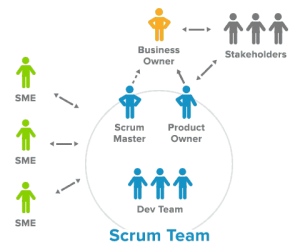— April 15, 2019
As your SaaS company matures, the development of a partner program is one enhancement you’ll likely want to make to your go-to-market strategy. You’ve proven product-market fit, you have a predictable direct sales pipeline, and your customer success team is growing your existing customers while keeping churn at a minimum. Adding a partner channel is a very natural next step as you scale.
If starting a company is like being a new parent, preparing for your newborn to arrive and having absolutely no idea of what to really expect, preparing for your partner program might feel the way I do right now as my teenagers are clamoring for their drivers’ licenses. I know them quite well at this point, so I can make some educated guesses as to what will likely go well and what will probably prove to be a challenge. In short, I know enough to be downright frightened, but I also have many tools I can leverage from my experience with them that will help me (please, oh please) support them as they enter this new stage of maturity.
You and your company have made it this far, and there are only a few—OK, four— must-haves that will help ensure your SaaS partner program is set on the right course.
1. Partner personas
If you haven’t researched and documented personas for your partner program, how will you know who will make the most ideal partner for your company? This foundational step is one of the most important in your entire partner strategy, and yet it is often skipped.
At a very basic level, your ideal partner persona should be someone who will provide you with access to your ideal customer or buyer persona. Conducting thorough partner persona research will provide you with the acquisition and enablement tools you’ll need to bring those ideal partners on board.
You love your product, and your entire day revolves around promoting and selling that product, so it can be easy to forget that your partners (whether current or future) aren’t keeping it as top of mind as you are. Your partner persona research will tell you:
- Why they might care about your product.
- How it solves a pain their customers are experiencing.
- How your product fits into their broader go-to-market strategy.
- What resources they will need to effectively fold your product into their strategy.
- How to best communicate with them.
If you haven’t yet created partner personas, there’s a wealth of information on the internet about marketing personas in general, and you can use any marketing or buyer persona tool or worksheet and apply it to your partners. My favorite is, of course, SmartBug’s own resource, The Ultimate Guide to Inbound Marketing Personas. If you need persona help stat, check it out in all its ungated glory.
2. Team resources
Partner or channel management can’t be someone’s side job. If you want to grow your partner program, you need to be prepared to dedicate resources—and I mean human resources—to this initiative. Your partner program requires a minimum of one person to recruit, vet, and onboard new partners.
Depending on the complexity of your product, you may also need technical resources either fully or at least partially dedicated to the partner program. It’s not uncommon for a customer success team to dedicate one customer success manager to the partner channel. This can also be a great way for your delivery team to get to know each partner, build rapport with them, and help the partner program leader better recruit and vet new partners.
In addition to these very focused human capital resources, you should also be prepared to dedicate marketing resources to building your partner program. What did it take to acquire your first 10 customers? Go ahead, think on that a while. It wasn’t easy, was it? It’s not enough to give one person a job title and a quota and expect partners to not only sign up, but actually start driving channel revenue for you.
Every company is different, and there’s not one be-all, end-all ramp period for a SaaS partner program. How long does it take you to hire? To train that new hire? For that new hire to ramp up? For that new hire to close business? These are the types of questions you should be asking yourself when you’re building KPIs for your partner program because they’re not unlike the questions you’ll be asking when you’re evaluating the effectiveness of your program.
3. Critical content
No one starts out their partner program with a library chock-full of training and sales enablement material, so cut yourself some slack. There are, however, a few really critical pieces of content that you need to have at the ready for your partners. Some of the most common resources include the following:
-
- Accurate pricing sheets. Trust your partners with the same level of access that you provide your sales team. Your partners need to know exactly how much your product will cost the customer, so avoid any “starting at” language that might set the wrong expectation early on in the sales process for everyone involved.
- Onboarding expectations. Whether you or your partner will be executing the new customer onboarding, these expectations need to be documented. If you are doing the onboarding and your partner is simply referring and perhaps co-selling with your team, it’s important that the co-selling partner understands your customer success process so they can adequately prepare your new customer. If the partner is delivering additional services that are related to your product, understanding the onboarding process will help them build their service timeline, which will help them realize new revenue faster, which will encourage them to refer more business to you.
- Technical information. Does your product integrate with other products? Does it REALLY integrate with other products? Are there any integrations you have listed on your website that (let’s be honest) aren’t fully baked as of yet? Don’t over-glamorize your capabilities when you are asking your partners to dedicate their own resources to you.
- Who’s who. A who’s who directory is especially helpful if you will have multiple direct reps collaborating with your partners. It’s a lot to expect your partners to remember every rep on your team, especially when they have their own companies and other SaaS companies as partners. Keeping this list updated will also help ensure your partners aren’t kept out of the loop when one of your team members leaves your company. There’s nothing worse than being in the middle of a co-selling deal and receiving a bounce-back email from the rep you’ve been collaborating with for weeks.
4. Processes
Although you may not have every single process fully mapped out, there are a few key processes you’ll need in place to ensure your partners feel comfortable collaborating with you. That being said, if you are a process junkie, make sure you provide yourself some wiggle room to finesse those processes, especially in your partner program’s infancy.
A process may make sense to you and look great on paper, but once you operationalize it with a partner, it might need to be adjusted. It’s better to make those adjustments and communicate them to your partner than to stay the course simply because you’ve decided it’s your process.
There’s one process that will matter most to your partners: lead and/or deal registration. Your partners need to have a clear mechanism for keeping track of the business they bring to you. Lead and deal registration technology is typically present in a PRM solution that you can purchase, and the benefit of this is that both you and your partner can keep tabs on the leads and deals you have in flight. This collaborative solution is most ideal, but it does come at a cost, so a simple shared spreadsheet might have to suffice while you prove out your partner program’s ROI.
You Can Do It
Building a partner program is an exciting time in your SaaS company’s growth. It’s not unusual to feel overwhelmed as you’re getting started, but having these four pieces in place will help ensure you are set up for success.
Business & Finance Articles on Business 2 Community
(25)





